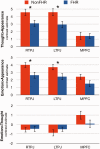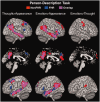Neural disruption to theory of mind predicts daily social functioning in individuals at familial high-risk for schizophrenia
- PMID: 24396009
- PMCID: PMC4249465
- DOI: 10.1093/scan/nst186
Neural disruption to theory of mind predicts daily social functioning in individuals at familial high-risk for schizophrenia
Abstract
Theory-of-mind (ToM) ability is foundational for successful social relationships, and dependent on a neurocognitive system, which includes temporoparietal junction and medial prefrontal cortex. Schizophrenia is associated with ToM impairments, and initial studies demonstrate similar, though more subtle deficits, in unaffected first-degree relatives, indicating that ToM deficits are a potential biomarker for the disorder. Importantly, the social consequences of ToM deficits could create an additional vulnerability factor for individuals at familial high risk (FHR). However, behavioral studies of ToM are inconsistent and virtually nothing is known about the neural basis of ToM in FHR or the relationship between ToM and social functioning. Here, FHR and non-FHR control participants underwent functional MRI scanning while reasoning about a story character's thoughts, emotions or physical appearance. Afterwards, participants completed a 28-day online 'daily-diary' questionnaire in which they reported daily social interactions and degree of ToM reasoning. FHR participants demonstrated less neural activity in bilateral temporoparietal junction when reasoning about thoughts and emotions. Moreover, across all participants, the degree of neural activity during ToM reasoning predicted several aspects of daily social behavior. Results suggest that vulnerability for schizophrenia is associated with neurocognitive deficits in ToM and the degree of deficit is related to day-to-day social functioning.
Keywords: fMRI; familial high risk; schizophrenia; social functioning; theory of mind.
© The Author (2014). Published by Oxford University Press. For Permissions, please email: journals.permissions@oup.com.
Figures



Similar articles
-
The neural basis of theory of mind and its relationship to social functioning and social anhedonia in individuals with schizophrenia.Neuroimage Clin. 2013 Nov 27;4:154-63. doi: 10.1016/j.nicl.2013.11.006. eCollection 2014. Neuroimage Clin. 2013. PMID: 24371798 Free PMC article.
-
Decreased activity in right-hemisphere structures involved in social cognition in siblings discordant for schizophrenia.Schizophr Res. 2012 Feb;134(2-3):171-9. doi: 10.1016/j.schres.2011.11.010. Epub 2011 Dec 3. Schizophr Res. 2012. PMID: 22137736
-
Subtle deficits of cognitive theory of mind in unaffected first-degree relatives of schizophrenia patients.Eur Arch Psychiatry Clin Neurosci. 2012 Apr;262(3):217-26. doi: 10.1007/s00406-011-0250-2. Epub 2011 Sep 4. Eur Arch Psychiatry Clin Neurosci. 2012. PMID: 21892777
-
Social cognition in youth with a first-degree relative with schizophrenia: A systematic scoping review.Psychiatry Res. 2023 May;323:115173. doi: 10.1016/j.psychres.2023.115173. Epub 2023 Mar 21. Psychiatry Res. 2023. PMID: 36989908
-
Interventions for the treatment of theory of mind deficits in schizophrenia: Systematic literature review.Psychiatry Res. 2018 Sep;267:37-47. doi: 10.1016/j.psychres.2018.05.001. Epub 2018 May 22. Psychiatry Res. 2018. PMID: 29883859
Cited by
-
Neural Correlates of Mentalizing in Individuals With Clinical High Risk for Schizophrenia: ALE Meta-Analysis.Front Psychiatry. 2021 Apr 20;12:634015. doi: 10.3389/fpsyt.2021.634015. eCollection 2021. Front Psychiatry. 2021. PMID: 33959048 Free PMC article. Review.
-
The Neural Basis of Social Cognition in Typically Developing Children and Its Relationship to Social Functioning.Front Psychol. 2021 Dec 10;12:714176. doi: 10.3389/fpsyg.2021.714176. eCollection 2021. Front Psychol. 2021. PMID: 34955950 Free PMC article.
-
F-18 fluorodeoxyglucose positron emission tomography study of impaired emotion processing in first episode schizophrenia.Schizophr Res. 2015 Mar;162(1-3):103-7. doi: 10.1016/j.schres.2015.01.028. Epub 2015 Feb 2. Schizophr Res. 2015. PMID: 25655909 Free PMC article.
-
Abnormalities in rich-club connections are associated with an exacerbation of genetic susceptibility to schizophrenia.BMC Psychiatry. 2024 Dec 27;24(1):951. doi: 10.1186/s12888-024-06411-w. BMC Psychiatry. 2024. PMID: 39731072 Free PMC article.
-
Thinking about others and the future: Neural correlates of perspective taking relate to preferences for delayed rewards.Cogn Affect Behav Neurosci. 2018 Feb;18(1):35-42. doi: 10.3758/s13415-017-0550-8. Cogn Affect Behav Neurosci. 2018. PMID: 29134457 Free PMC article.
References
-
- Adolphs R. Neural systems for recognizing emotion. Current Opinion in Neurobiology. 2002;12(2):169–77. - PubMed
-
- Aiken LS, West SG. Multiple Regression: Testing and Interpreting Interactions. Thousand Oaks, CA: Sage; 1991.
-
- Anselmetti S, Bechi M, Bosia M, et al. ‘Theory’ of mind impairment in patients affected by schizophrenia and in their parents. Schizophrenia Research. 2009;115(2–3):278–85. - PubMed
-
- Beck AT, Steer RA, Brown GK. Manual for Beck Depression Inventory-II. San Antonia, TX: Psychological Corporation; 1996.
Publication types
MeSH terms
Substances
Grants and funding
LinkOut - more resources
Full Text Sources
Other Literature Sources
Medical

